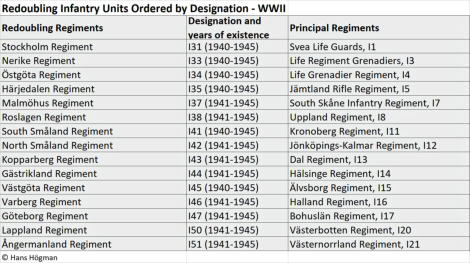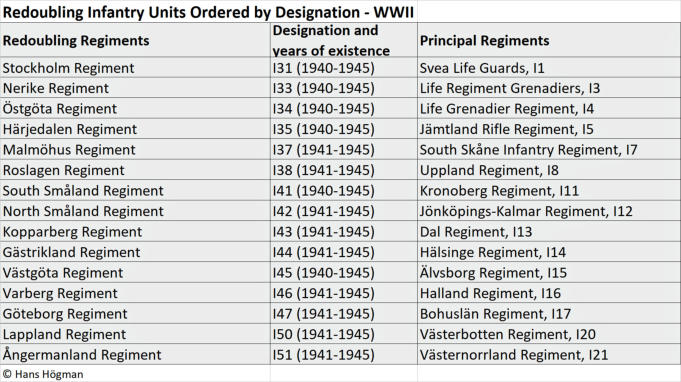

Copyright © Hans Högman 2020-12-15


Swedish Military
War Units - WWII
Introduction
At the outbreak of WWII in 1939, in a State of the
Nation Address, Swedish Prime Minister P. A.
Hansson stated “our military preparedness is very
good”. This wasn’t entirely true. A few years after the
First World War, Sweden downsized its armed
forces. This of course had a big effect on Sweden’s
preparedness in 1939. The major problem wasn’t
the reduced number of soldiers but fewer trained
officers. In 1939, when Sweden was rearming its
armed forces, there was a shortage of trained,
experienced officers.
At the outbreak of WWII on 1 September 1939,
Sweden made a partial mobilization two
strengthen its military preparedness. These forces
were called the Neutrality Watch (Swe:
Neutralitetsvakten) and were in service throughout
the war.
On 30 November 1939, the Soviet Union invaded
our neighboring country Finland, the so-called
Winter War. Therefore, on 2 December, Sweden
made a more extensive partial mobilization, in
connection with the Soviet attack on Finland. An
army division of 100,000 men was mobilized to
protect Sweden’s north-eastern border with Finland.
When the Soviets invaded Finland in November
1939, Sweden formed a coalition government,
headed by Prime Minister Per Albin Hansson. The
new government immediately initiated a Defense
Commission, which recommended substantial
rearmament of the Swedish Armed Forces, both in
quality and quantity.
On 17 June 1942, The Defense Act was unanimously
passed in the Parliament. The budget was increased
to 755 million SEK a year, which corresponded to
about 4,6% of the GNP.
The image to the
right shows a troop
of Swedish infantry
soldiers wearing
uniform m/1939 at
a Bofors 37mm
antitank gun
m/1938.
Fordonsmuseet
Arsenalen,
Strängnäs. Photo, Hans Högman 2016.
Redoubling Regiments
The armament Sweden performed during World
War II involved the establishment of many new
military units.
Following the Swedish war organization of 1941,
each regular infantry regiments were, in case of
war, to be reorganized into so-called depot
regiments. Each of the depot regiments must
organize two war regiments (field-regiments), one
principal regiment, and one so-called
“Dubblingsregemente”. “Dubblingsregemente literally
means “Redoubling regiment”. Thereby the
number of infantry regiments were redoubled,
hence the term. I guess you can also call these
regiments, “extra regiments”, twin regiments”, “sister
regiments”, etc.
War regiment or field-regiment was a term used for
the infantry regiments of the Swedish war
organization and was the result of the 1941 war
organization which was confirmed by the 1942
Defense Act. In Swedish, the term
“Fördubblingsregemente” is used as a synonym for
“Dubbleringsregemente”.
However, not all infantry regiments established
redoubling regiments; Värmland Regiment (I 2),
Gotland Infantry Regiment (I 18), and Norrbotten
Regiment (I 19) did not. Further, the former infantry
regiments Skaraborg Regiment (I 9), and
Södermanland Regiments (I 10) were reorganized
into armored tank regiments.
Unit designation
The redoubling regiments kept the unit designation
of its principal regiment plus 30. For example, the
Älvsborg Regiment had the unit designation I15 and
its redoubled regiment then received the
designation I45 (I15 + 30) and the name Västgöta
Regiment. A redoubling regiment was assigned a
regimental name according to the tradition of its
principal regiment or by its catchment area.
The letter “I” in an infantry regiment’s designation
denotes “Infantry”, for example, I15, i.e. 15th
infantry regiment.
Below is an example of a redoubling regiment,
Östgöta Regiment (I34), established in 1940:
•
I34s headquarters and its 13th and 14th
companies were raised by the Life Grenadier
Regiment (I4), Linköping.
•
1st battalion was raised by the I4.
•
2nd battalion was raised by the Life Regiment
Grenadiers (I3), Örebro.
•
3rd battalion was raised by the North Skåne
Infantry Regiment (I6), Kristianstad.
In the following year, 1941, the entire I34 regiment
was organized under the Life Grenadier Regiment
(I4).
The image to the right
shows an all-terrain
vehicle m/1942 VL
(Swe: Terrängbil (TGB)
m/42 VL). It was an
all-wheel drive truck
manufactured by
Volvo.
Museum:
Fordonsmuseet Arsenalen, Strängnäs. Photo: Hans
Högman 2016.
Redoubling Regiments during World War II



Landstorm Regiments
For local defense purposes, there
were at the beginning of WWII so-
called landstorm regiments
established with the older classes of
men of draft age, ages 35 - 42. The
Landstorm units were territorial units to be used
solely for the defense of home areas and to
safeguard the mobilization of the field army.
Before1936, the landstorm units weren’t allowed to
be used outside their local or adjacent enrollment
areas. In 1936 the soldiers of the landstorm units had
to do an obligatory refresher military training course
for 5 days and their commanders, a refresher course
of 7 days. At the beginning of WWII (1939 - 1941), the
landstorm units were mobilized.
The Landstorm regiments’ unit designation began
with the letter “L” followed by a number in the
interval 1 - 21. The number after the ”L” denotes the
enrollment area where they were raised. For
example, the unit designation L7 denotes the
landstorm regiment raised in Malmöhus North
Enrollment Area (inskrivningsområde (Io7)) and L11
denotes the landstorm regiment raised in Kronoberg
Enrollment Area (inskrivningsområde (Io11)). “Io” =
Inskrivningsområde (Enrollment Area).
See below:
Enrollment Areas 1902 - 1969
1.
Stockholms inskrivningsområde, Io1
2.
Värmlands inskrivningsområde, Io2
3.
Örebro inskrivningsområde, Io3
4.
Östergötlands inskrivningsområde, I4
5.
Jämtlands inskrivningsområde, Io5
6.
Malmöhus norra inskrivningsområde, Io6
7.
Malmöhus södra inskrivningsområde, Io7
8.
Uppsala inskrivningsområde, Io8
9.
Skaraborgs inskrivningsområde, I9
10.
Södermanlands inskrivningsområde, Io10
11.
Kronobergs inskrivningsområde, I11
12.
Norra Smålands inskrivningsområde, I12
13.
Kopparbergs inskrivningsområde, Io13
14.
Gävleborgs inskrivningsområde, Io14
15.
Älvsborgs inskrivningsområde, I15
16.
Hallands inskrivningsområde, I16
17.
Västgöta-Bohus inskrivningsområde, I17
18.
Gotlands inskrivningsområde, Io18
19.
Norrbottens inskrivningsområde, Io19
20.
Västerbottens inskrivningsområde, Io20
21.
Västernorrlands inskrivningsområde, Io21
Territorial Regiments
The landstorm regiments mentioned above were in
use until 1942. In the 1942 Defense Act, they became
territorial regiments (Swe: Lokalförsvarsregimenten).
These units were thereafter assigned new unit
designations, for example, I151; the two first digits
denoted the military district (Swe: Försvarsområde)
they were raised in. Försvarsområde (short: Fo) =
Defense District (DD).
For instance: I151; this was Blekinge Regiment raised
in Blekinge Defense District (Fo15); I181 was Öland
Regiment in Kalmar Defense District (Fo18);
Regiments I 441to 442 in Stockholm M.D. (Fo44) and
regiments I 521 to 523 in Karlstad DD (Fo52) etc.
Defense Districts 1942 -
Swedish name: (Försvarsområde (Short: Fo).
The Defense Districts (Försvarsområden (Fo)) were a
result of the 1942 Defense Act and they were a lower
level subdivision of the Swedish armed forces. It
followed Sweden’s subdivision of Län (Counties). The
commander of a defense district was the Defense
District Commander.
The Defense Districts (Försvarsområden (Fo)) were a
subset of the Military Command Regions
(Militärområden (Milo)).
The Defense District Commander answered to the
larger Military Command Region that the defense
district was part of.
•
Fo11, Malmö försvarsområde (1942 - 1975)
•
Fo12, Ystads försvarsområde (1942 - 1946)
•
Fo13, Helsingborgs försvarsområde (1942 - 1945)
•
Fo14, Kristianstads försvarsområde (1942 - 1975)
•
Fo15, Blekinge försvarsområde (1942 - 1947)
•
Fo16, Växjö försvarsområde (1942 - 1943)
•
Fo17, Jönköpings försvarsområde (1942 - 1943)
•
Fo16/Fo17, Växjö-Jönköpings försvarsområde
(1943 - 1946)
•
Fo18, Kalmar försvarsområde (1942 - 1946)
•
Fo21, Gävle försvarsområde (1942 - 1966)
•
Fo22, Östersunds försvarsområde (1942 - 1974)
•
Fo23, Härnösands försvarsområde (1942 - 1974)
•
Fo24, Hemsö försvarsområde (1942 - 1957)
•
Fo25, Sundsvalls försvarsområde (1947 - 1955)
•
Fo31, Halmstads försvarsområde (1942 - 1958)
•
Fo32, Göteborgs försvarsområde (1942 - 1958)
•
Fo33, Göteborgs skärgårds försvarsområde (1942 -
1958)
•
Fo34, Uddevallas försvarsområde (1942 - 1958)
•
Fo35, Skövdes försvarsområde (1942 - 1974)
•
Fo41, Linköpings försvarsområde (1942 - 1975)
•
Fo42, Norrköpings försvarsområde (1942 - 1953)
•
Fo43, Strängnäs försvarsområde (1942 - 1973)
•
Fo44, Stockholms försvarsområde (1942 - 2000)
•
Fo45, Norrtälje försvarsområde (1942 - 1946)
•
Fo46, Stockholms skärgårds försvarsområde (1942
- 1946)
•
Fo47, Uppsala försvarsområde (1942 - 1974)
•
Fo48, Västerås försvarsområde (1947 - 1974)
•
Fo49, Gävle försvarsområde (1966 - 1973)
•
Fo51, Örebro försvarsområde (1942 - 1975)
•
Fo52, Karlstads försvarsområde (1942 - 1973)
•
Fo53, Falu försvarsområde (1942 - 1973)
•
Fo54, Mora försvarsområde (1942 - 1973)
•
Fo61, Umeå försvarsområde (1942 - 1973)
•
Fo62, Storumans försvarsområde (1942 - 1966)
•
Fo63, Bodens försvarsområde (1942 - 1997)
•
Fo64, Luleå försvarsområde (1942 - 1946)
•
Fo65, Jokkmokks försvarsområde (1942 - 1975)
•
Fo66, Kiruna försvarsområde (1942 - 1997)
•
Fo67, Morjärvs försvarsområde (1942 - 1946), Kalix
försvarsområde (1947 - 1994)
Military Joint Command Regions
Swedish name: Militärområden (Short: Milo).
In 1942, the military subdivision of Sweden into
Military Joint Command Regions (Militärområden
(Milo)) replaced the former so-called “Arméfördelning”.
The Military Joint Command Regions were multi-
service commands of the Swedish Armed Forces.
Each Milo had a Joint Command headed by a Milo
Commander (Militärbefälhavare (MB).
From 1942, the Milo Commander (MB) had the
operational responsibility of all army forces in his
Military Command Region (Milo).
The image shows the
Swedish medium
tank, Stridsvagn
m/1942 (Strv m/42). A
22.5 ton tank which
fielded a 75 mm L/31
gun, and two 8 mm
machine guns. Crew:
4. Museum:
Fordonsmuseet
Arsenalen, Strängnäs. Photo: Hans Högman 2016.
Army Divisions
Swedish name: Arméfördelning.
An “Arméfördelning” or simply “fördelning” was in the
20th century the Swedish term for a large army
military unit consisting of two or several brigades, an
artillery regiment, an army engineer battalion, an
anti-aircraft battalion, a signal battalion, and an army
supply battalion. The English equivalence would be
an Army Division.
Through the Defense Act of 1942, the I-IV Military
Command Regions (Milo) came to mobilize two
divisions each, while the V and VI Milo each mobilized
one army division.
Army Divisions 1937 - 1942:
•
I. arméfördelningen,
Helsingborg
1937–1939, Kristianstad 1939–1942
•
II. arméfördelningen,
Östersund
1937–1942
•
III. arméfördelningen,
Skövde
1937–1942
•
IV. arméfördelningen,
Stockholm
1937–1942
•
Gotland Milo,
Visby
1937–1942
•
Upper Norrland units,
Boden
1937–1942
Between 1940 and 1941, i.e. at the beginning of
WWII, three new army divisions were established.
They were:
•
VII. arméfördelningen, established in July 1940
•
VIII. arméfördelningen, established in October
1940
•
IX. arméfördelningen, established in January 1941
The Swedish military preparedness was during 1940
and 1941 above all maintained by these new army
divisions.
The VII. arméfördelningen was comprised of; VII.
Division Headquarters, 7. Division Signal Company,
I33, I34, I41, V. Cavalry Battalion, A12, II. Engineer
Battalion, III. Battalion I402, VII. Army Service Troops,
7. Division Quartermaster Company, and 7. Field
Ambulance Company.
The VIII. arméfördelningen was comprised of; VIII.
Division Headquarters, 8. Division Signal Company,
I31, I35, I36, VIII. Cavalry Battalion, A13, VIII. Engineer
Battalion,, II. Battalion I402, VIII. Army Service Troops,
8. Division Quartermaster Company, and 8. Field
Ambulance Company.
The IX. arméfördelningen was comprised of; IX.
Division Headquarters, 9. Division Signal Company,
I38, I42, I44, IX. Cavalry Battalion, A14, IX. Engineer
Battalion,, IX. Army Service Troops, 9. Division
Quartermaster Company, and 9. Field Ambulance
Company.
The Army Divisions (Arméfördelning) above were
called combat support divisions (täcktruppfördelningar)
since their major task was, in case of an enemy attack
on Sweden, to support and secure the mobilization
and deployment of more powerful troops.
These divisions were therefore deployed in the
regions or areas of Sweden where a possible enemy
attack was most likely to occur.
Between September and November 1940, the VII.
arméfördelning, therefore, were deployed at
Sweden’s north-eastern border to Finland. Between
October 1940 and 15 March 1941 the VIII.
arméfördelning was deployed in the same area. The
IX. arméfördelningen, established in January 1941
was on the other hand deployed in Värmland by the
Norwegian border. Some of these combat support
units were also deployed on the Island of Gotland.
The infantry regiments were each organized in 3
battalions and each battalion was comprised of 4
companies. Each regiment had, besides the 12
regular companies, further 2 companies; a machine
gun company (13.) and a heavy weapons company
(14.).
Source: Beredskapsverket, Avdelning 1 (o) A:2 (1940-
1943) Bild 110 / sid 3 (AID: v789545.b110.s3, NAD:
SE/KrA/0279001Ö).
Army Divisions 1942 - 1966:
•
I. arméfördelningen,
I. militärområdet,
Kristianstad
•
II. arméfördelningen,
II. militärområdet,
Östersund
•
III. arméfördelningen,
III. militärområdet, Skövde
•
IV. arméfördelningen,
IV. militärområdet,
Strängnäs
•
XI. arméfördelningen,
I. militärområdet,
Kristianstad
•
XII. arméfördelningen,
II. militärområdet,
Östersund
•
XIII. arméfördelningen,
I. militärområdet,
Kristianstad (tank division)
•
XIV. arméfördelningen,
IV. militärområdet,
Linköping
•
XV. arméfördelningen,
VI. militärområdet, Boden
•
XVI. arméfördelningen,
V. militärområdet, Karlstad
The army divisions (arméfördelningar) with a
designation beginning on the Roman numeral “X”
were redoubling army divisions. For example: the XIII.
arméfördelning was a redoubling division organized
by the III. Army Division.
Militärområde (Milo) = Military Joint Command
Region.
Military Joint Command Regions (Milo) 1942 -
1966
In 1942, Sweden was subdivided into seven military
joint command regions (militärområden, Milo),
designated Roman numeral I to VII. Each Milo was
under the command of a Militärområdesbefälhavare
(MB) - Joint Commander.
Following the 1942 Defense Act, the I. – IV. Joint
Command Regions organized two army divisions
each, while the V. and VI. Joint Command Regions
only one division each.
•
I. militärområdet
Kristianstad
1942–1966
•
II. militärområdet
Östersund
1942–1966
•
III. militärområdet
Skövde
1942–1966
•
IV. militärområdet
Stockholm
1942–1963,
Strängnäs 1963–1966
•
V. militärområdet
Stockholm
1942–1942,
Karlstad 1942–1966
•
VI. militärområdet
Boden
1942–1966
•
VII. militärområdet
Visby
1942–1966
Militärområde = Military Joint Command Region.


1942 Defense Act
The 1942 Defense Act (Swe: Försvarsbeslutet 1942
or FB 42) was passed in the Swedish Parliament on 17
June 1942 (Government bill no 210, 1942.)
A new subdivision of Sweden for military purposes
was implemented. The term Arméfördelning (army
division) was kept, but now only for the field units.
The territorial use of the term was changed to
Militärområde (Milo). This term is usually translated
into Military Joint Command Region in English.
The Swedish Armed Forces were increased with two
new army divisions (arméfördelningar), now
comprising six divisions.
Further, a new branch of the army was established:
the Anti-aircraft Defense (Swe: Luftvärnet). Before
1942, the anti-aircraft defense was a subdivision
within the Artillery. The Armored Troops (Swe:
Pansartrupperna) became an independent branch of
the Army. Before 1942 they were a subdivision of the
infantry. Also, a new branch was the Army
Ammunition Depot Troops (Swe: Tygtrupperna). The
“Tygtrupperna” existed between 1942 and 1948 when
they were consolidated with the Army Service Troops
(Swe: Trängtrupperna).
The infantry was ordered to establish so-called
redoubling regiments (Swe: Dubbleringsregementen),
which were organized as field regiments (see above).
The Defense Act also included the establishment of
five new Air Force Wings, in total there were now 16
air wings comprising six bomber air wings, six fighter
air wings, three reconnaissance air wings and, one
torpedo air wing. In 1944, a seventh Fighter Air Wing
was established, F 18 in Tullinge, south of Stockholm.
To the Navy, the 1942 Defense Act wasn’t implying
any major changes. The vessels were upgraded and
modernized and the number of officers was
increased. The Coast Artillery, a subbranch of the
Navy, was extended.
The Period of Training of Draftees
in the 20th century, the Swedish Armed Forces relied
on conscription (Swe: Värnplikt) with a core of
professional officers.
In 1936 (1936 Conscription Act), the military period of
training of the infantry draftees was increased to 175
days including a refresher course of 25 days.
In 1941, the military period of training of the draftees
was increased to 450 days, including an initial service
of 360 days and 3 refresher courses of 30 days each.
In 1914, the draft age was laid down to the age of
20. In 1942, the age when a draftee was unregistered
from the military was fixed to the age of 47.
In total, about 1,000,000 Swedish conscripts were, in
different stages, drafted for military service during
World War II, 1939 - 1945; at the most about 300,000
simultaneously.
This period in Sweden, 1939 – 1945, is known as the
“Beredskapstiden” or “Beredskapsåren” by Swedes.
For more information, see:
The organization of the Swedish armed forces in the
20th century - conscription and
Sweden’s military preparedness 1939 - 1945





















